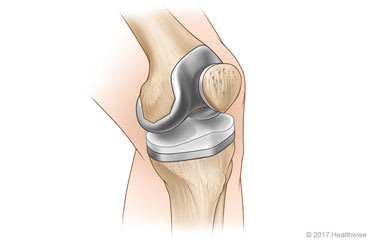Exercises after surgery

These exercises can be done right after your surgery. You can do them in your hospital bed. Talk to your doctor before you start any of these exercises. Your doctor may tell you to do them in a certain way. You may need to do them several times each day. When you first do them, they may hurt. Your knee may click or pop. But these exercises will help you recover and may help your pain go away faster.
Quad set
- Sit or lie down on a firm surface or the floor with your affected leg straight. Place a small, rolled-up towel under your knee.
- Tighten the thigh muscle of your straight leg by pressing the back of your knee down into the towel.
- Hold for about 6 seconds, then rest.
- Repeat 8 to 12 times.
Hip flexion (lying down, leg straight)
- Lie on your back with your affected leg straight. You can bend your other leg, if that feels more comfortable.
- Tighten the thigh muscles in your affected leg by pressing the back of your knee down. Hold your knee straight.
- Keeping the thigh muscles tight and your leg straight, lift your affected leg up so that your heel is about 12 inches off the surface. Hold for about 6 seconds, then lower slowly.
- Repeat 8 to 12 times.
- It's a good idea to repeat these steps with your other leg.
Ankle pump
- Lie or sit on a firm surface with your feet out in front of you.
- Point your toes and feet up toward your knees as far as you can. Then point them away from you as far as you can.
- Switch between pointing your feet up and pointing them down.
- Do this for 2 to 3 minutes, 2 to 3 times an hour.
Quadriceps (thigh) strengthening
- While sitting in a chair, straighten your leg and hold for 6 seconds. Do not lock your knee. Then slowly lower your leg.
- Repeat 8 to 12 times with each leg.
- It's a good idea to repeat these steps with your other leg.
Heel slide
- Lie on your back with your affected leg straight. Bend your other leg.
- Slowly bend your affected knee by raising your knee up while sliding your foot toward you. Bend your knee as much as you can.
- Hold for about 6 seconds. Then slowly slide your foot away, lowering your leg back down.
- Repeat 8 to 12 times.
Later exercises
When you are able to walk on your own for a few steps or a short distance, you can try these exercises. Talk to your doctor before starting any of these exercises. Your doctor may tell you to do them in a certain way. You may need to do the exercises 2 or 3 times each day.
Knee raise (standing)
- Stand up straight. Use your walker or crutches or hold onto something stable, such as a counter.
- Lift the thigh of your affected leg as high as you can, letting your knee bend.
- Hold for about 6 seconds.
- Lower your leg, and touch the floor with your heel first.
- Repeat 8 to 12 times.
Heel slide (ankles crossed)
- Lie on your back with your knees bent.
- Slide your heel back by bending your affected knee as far as you can. Then hook your other foot around your ankle to help pull your heel even farther back.
- Hold for 6 seconds. Then slowly return to your starting position.
- Repeat 8 to 12 times.
Follow-up care is a key part of your treatment and safety. Be sure to make and go to all appointments, and call your doctor if you are having problems. It's also a good idea to know your test results and keep a list of the medicines you take.
Where can you learn more?
Go to http://www.healthwise.net/patientEd
Enter Q459 in the search box to learn more about "Knee Replacement Rehabilitation".
Current as of: July 31, 2024
Author: Ignite Healthwise, LLC Staff
Clinical Review Board
All Ignite Healthwise, LLC education is reviewed by a team that includes physicians, nurses, advanced practitioners, registered dieticians, and other healthcare professionals.

